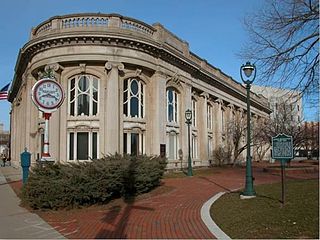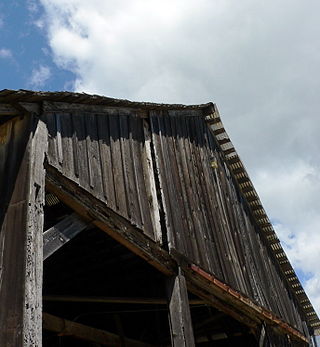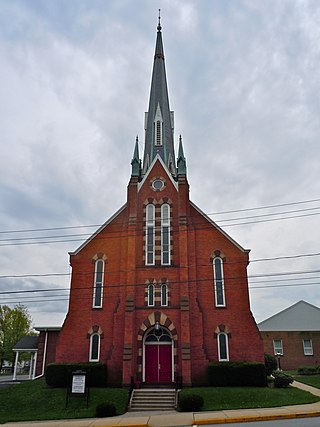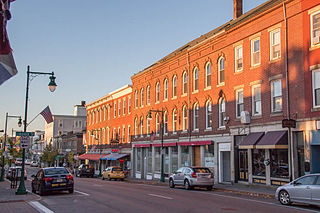Related Research Articles

Limekiln State Park is a California state park on the Big Sur coast. It contains four lime kilns from an 1887–1890 lime-calcining operation, plus a beach, redwood forest, and 100-foot (30 m) Limekiln Falls. It is located 2 miles (3.2 km) south of Lucia on Big Sur Coast Highway. The 711-acre (288 ha) park was established in 1994.

Mortdale is a suburb located in southern Sydney, in the state of New South Wales, Australia. Mortdale is located 20 kilometres south of the Sydney central business district and is part of the St George area. Mortdale is situated in the local government area of Georges River Council. Mortdale extends south to Lime Kiln Bay, on the Georges River. Mortdale Heights is a locality in the western corner of the suburb.

Trimborn Farm is a Victorian era estate located in Greendale, Wisconsin, United States, and owned by Milwaukee County. Spanning 7.5 acres and nine buildings, it is listed on the National Register of Historic Places. The farm is also a State Historic Site and designated Milwaukee County Landmark.

Lime Rock (Limerock) is a village and historic district in Lincoln, Providence County, Rhode Island, United States, near Rhode Island Route 146. The village was named after the limestone quarries in the area, which started in the 17th century, and continue to the present where Conklin Limestone Company now operates. Because of the abundance of limestone in the area many houses had massive end chimneys and were called "stone enders," a distinctly Rhode Island style of architecture. The historic district includes 21 historically significant properties in an area extending from Wilbur Road, just west of its junction with Old Louisquisset Pike, eastward to Great Road, and then along Great Road as far as Simon Sayles Road. Among these properties are three quarries, and the ruins of three old lime kilns. It was listed on the National Register of Historic Places in 1974.

The Milwaukee County Historical Society, also known as MCHS, is a local historical society in Milwaukee County, Wisconsin. Founded in 1935, the organization was formed to preserve, collect, recognize, and make available materials related to Milwaukee County history. It is located in downtown Milwaukee in the former Second Ward Savings Bank building.

The Cowell Lime Works, in Santa Cruz, California, was a manufacturing complex that quarried limestone, produced lime and other limestone products, and manufactured wood barrels for transporting the finished lime. Part of its area is preserved as the Cowell Lime Works Historic District, which was listed on the National Register of Historic Places in 2007. In addition to the four lime kilns, cooperage and other features relating to lime manufacture, the Historic District also includes other structures associated with the Cowell Ranch, including barns, a blacksmith shop, ranch house, cook house and workers' cabins. The 32-acre Historic District is located within the University of California, Santa Cruz campus, to either side of the main campus entrance.
Cooper House, Cooper Farmhouse, or Cooper Farm may refer to

The Wrightsville Historic District is a national historic district that is located in Wrightsville in York County, Pennsylvania.

The Milwaukee Falls Lime Company is the former owner of a limestone quarry and lime kilns located in Grafton, Wisconsin. It was added to the National Register of Historic Places in 2012. The quarry and kilns are now Lime Kiln Park, which also features a pavilion, playground, walking paths, sledding hill, horseshoe pits, and disc golf course.

The John Eakin Farm, also known as the Jacob Kooker Tavern, is an historic farm and national historic district that are located in Springfield Township, Bucks County, Pennsylvania.
Prospectville is a populated place on the northwestern end of Horsham Township, a home rule municipality of Montgomery County, Pennsylvania, United States. Prospectville is located at the intersection of state routes 152 and 463. It is located about 18 miles (29 km) north of the city center of Philadelphia and 89 miles (143 km) east of Pennsylvania's capital city of Harrisburg. It is 12 miles (19 km) northeast of Norristown, the county seat, and six miles (9.7 km) southeast of Lansdale, its shipping depot. It is located within the Hatboro-Horsham School District and is served by the Ambler post office within ZIP code 19002.
Lime Kiln, or variants, may refer to:

Eastburn–Jeanes Lime Kilns Historic District is a national historic district located near Newark, New Castle County, Delaware. It encompasses six contributing buildings, two contributing sites, and eight contributing structures. They are eight line kilns and two abandoned quarries, together with stone buildings erected by Abel Jeanes and Joseph Eastburn. The buildings include the Abel Jeans Manor House, Blacks Mill, horse stable, and outhouse. They reflect the local lime-burning industry that started in 1816, and operated into the early 1900s.

The Main Street Historic District encompasses the historic commercial heart of Rockland, Maine. Located on several blocks of Main Street, the district has a well-preserved collection of commercial architecture dating from the mid-19th to early 20th centuries, the period of the city's height as a shipbuilding and industrial lime processing center. The district was listed on the National Register of Historic Places in 1978, and enlarged in 2012.

Hurstville Historic District is a nationally recognized historic district located north of Maquoketa, Iowa, United States. It was listed on the National Register of Historic Places in 1979. At the time of its nomination it included three areas: the former lime manufacturing works, a farmstead, and the townsite. All that remains are the four kilns, and an old warehouse. Both the townsite, which was across the road and to the southwest, and the farmstead, which was behind the kilns to the south, are gone. Also gone are the remaining company buildings, with the exception of the old warehouse, which were across the road to the west. The houses in the townsite were side-gable cottages. Many lacked indoor plumbing into the 1970s and were vacant. The farmstead included 20 structures devoted to domestic or agricultural use. Two large barns were the most notable structures. The farm served the needs of the town. The most significant structures in the district were the lime kilns.

The John Smith House is a historic building located at 124 Washington Valley Road in the Washington Valley section of Morris Township in Morris County, New Jersey, United States. It was documented by the Historic American Buildings Survey (HABS) in 1937. The house was added to the National Register of Historic Places on January 1, 1976, for its significance in agriculture and architecture. It was designated a contributing property of the Washington Valley Historic District on November 12, 1992.
Druecker is an unincorporated community in the Town of Port Washington, Ozaukee County, Wisconsin, United States. The community is located on the east bank of Sauk Creek, and the Union Pacific railroad operates tracks passing through Druecker.

The Moses Craig Lime Kilns, also known as the Peapack and Gladstone Lime Kilns, are located at 122 Main Street in the borough of Peapack-Gladstone in Somerset County, New Jersey, United States. Built c. 1860, the lime kilns, listed as the Moses Craig Limekilns, were added to the National Register of Historic Places on April 11, 2019. The Historical Society of the Somerset Hills acquired the site in 1998. The kilns were subsequently transferred to the borough in 2019.
References
- 1 2 3 Federal Highway Administration, Indiana Department of Transportation, and Kentucky Transportation Cabinet. Supplemental Final Environmental Impact Statement. FHA et al via Ohio River Bridges Project, n.d., 5-69.